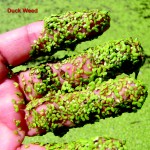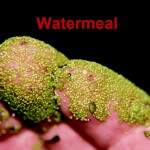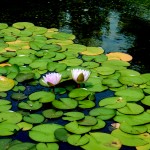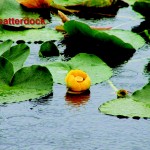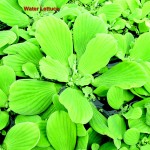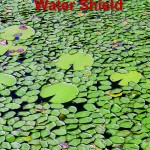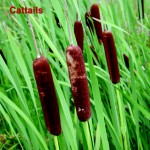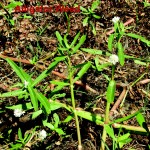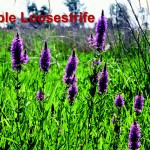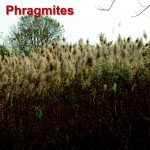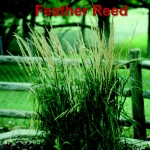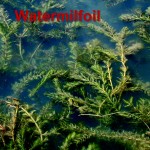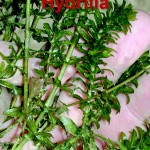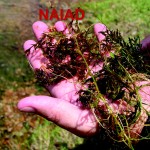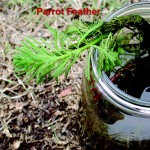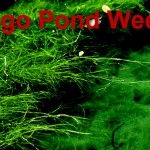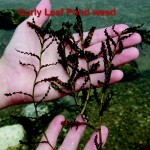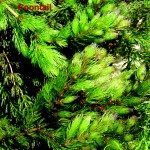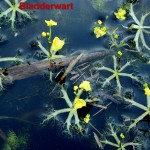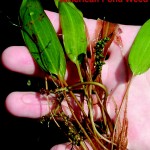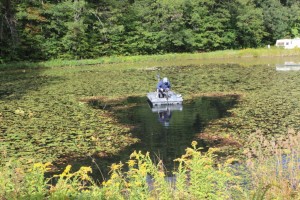 Pond weeds can become unsightly, choke out the pond view, stunt fish growth, eliminate swimming and even fishing by getting caught up in all the weeds. Excessive weeds can also be dangerous if you should fall over board and become entangle in the weeds. Most of the time we start off on the right track by adding plants for habitat, shade and our visual pleasure, but we tend not to manage them, they get out of control and can take over the pond. At this point we are disgusted and call them weeds. Don’t get me wrong but geese and other water fowl can bring in the unwanted weeds, wind and animal movement, boats, waders and unwanted aquarium contents can get weeds started in a pond or lake too.
Pond weeds can become unsightly, choke out the pond view, stunt fish growth, eliminate swimming and even fishing by getting caught up in all the weeds. Excessive weeds can also be dangerous if you should fall over board and become entangle in the weeds. Most of the time we start off on the right track by adding plants for habitat, shade and our visual pleasure, but we tend not to manage them, they get out of control and can take over the pond. At this point we are disgusted and call them weeds. Don’t get me wrong but geese and other water fowl can bring in the unwanted weeds, wind and animal movement, boats, waders and unwanted aquarium contents can get weeds started in a pond or lake too.
It seems the first thing that pops into our heads is to kill the weeds, what chemical can we use to kill these weeds? This is the Reactive approach to unwanted weeds is by the use of chemicals which depends on proper weed identification and choosing the proper chemical for that specific weed. Every chemical has Caution on the bottle, for your safety and the environment safety s well. Only 1/3 or 1/2 of the pond can be treated at a time due to the mass of dead, decaying weeds consuming oxygen in the pond leaving a greater chance of a fish kill. Then this mass of plants/weeds are now adding more muck and nutrients to the pond.
Once a reactionary method has taken place look towards a Proactive approach by installing the proper sized aeration system, beneficial bacteria’s, Muck and Sludge Remover to reduce the mucky bottom even our pond dye for a pleasant color of water. Ideally it would be a good move to add the proper aeration system first to keep oxygen in the pond while the weed decay.
Non chemical approach includes the use of the tri ploid grass carp, which in many states are regulated and permitting process must be sought out first before obtaining these fish. They do a decent job on eating the weeds but also weed identification is important as some species of weeds are not on their dietary list.
Let’s get physical in removing pond weeds. This part of pond weed control is hard work, I’ll say that up front so there no mistake. Yes there are tools to help make the job easier but using a weed cutter and raking them out of the pond can be a good work out, but the weed will come back, picture this like mowing the field we got the main bulk of weeds cut down but will grow back. The main tool here are a weed cutter and floating rake and each have an extension so the handle is 11′ feet long, tie a rope on and get out even farther in the pond.
Still working with physical tools so to speak is the Lake Mower, a 12 volt 48″ wide sickle bar able to reach down 7′ of depth and cut the weeds from a boat(pictured above). There are options for a boat mounted rake to push the cut weeds to shore but still physical to get them from shore to the dump site. But if you tried to manually cut weeds for a day the Lake Mower will still be a lot less strain on you.
Another tool for weed control is the Lake Bottom Blanket, all blankets are 10 3/4′ feet wide and start at 20′ in length. 3/8″ diameter re-bar needs to be purchased and cut on site, since shipping heavy steel is quit expensive. The process is to cover the weed area and allow the blanket to suffocate the weeds, but not suffocate the floor of the pond harming the smaller life. Non toxic easy to use and minimal maintenance, but effective in killing the weeds.
Algae
30,000 different species, some are toxic, killing live stock, dogs and close beaches. But on the other hand there are algae that are beneficial for the pond to sustain life in starting the food chain.
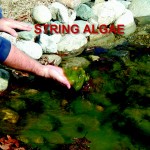
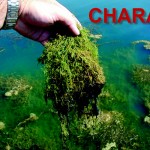
With the thousands of weed species we group them below in a classification of how they grow and where they grow. Also listing a few invasive species too.
Floating Weeds
Emergent Weeds
Submerged Weeds

